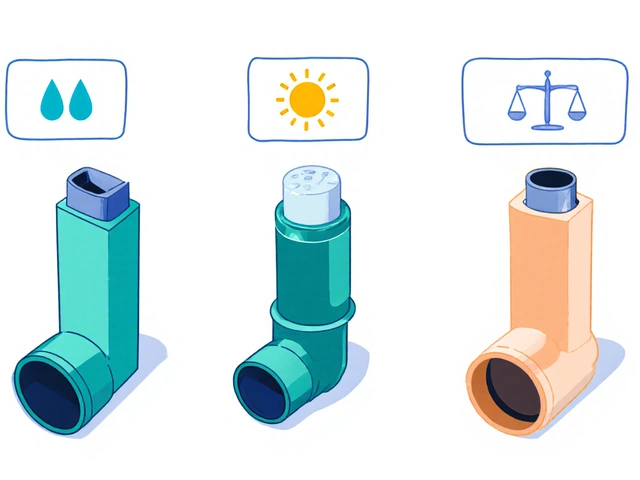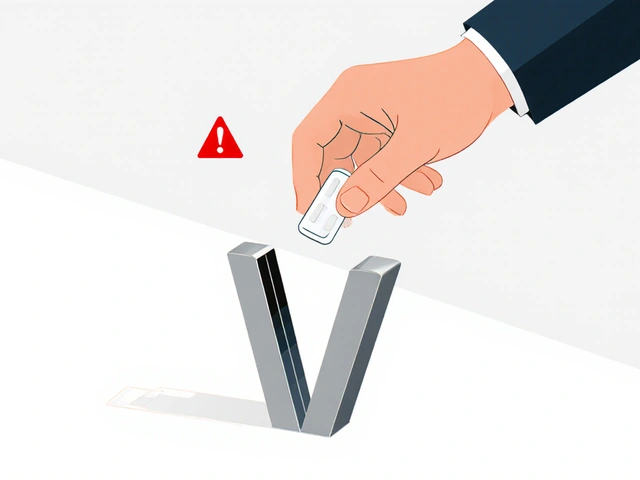You’d be surprised how often one little pill changes the course of people’s lives. Lasix isn't new on the scene—doctors have trusted it for decades. It’s the go-to diuretic, often called a "water pill," that works when nothing else will get that stubborn fluid out of the body. Whether your ankles balloon up like balloons after salty pizza or you’re fighting heart failure, this pill is probably somewhere in your healthcare journey. But yeah, there’s way more to know about Lasix than most people realize—especially if you want it to help more than it hurts. And trust me, Lasix can come with both benefits and headaches, sometimes all at the same time.
How Lasix Works and Why It’s Prescribed
Lasix’s boring name is furosemide, but the way this pill works is actually pretty wild. It tackles a part of your kidneys called the loop of Henle (sounds fancy, but basically where a lot of your pee magic happens). Lasix blocks the reabsorption of sodium and chloride, so you end up losing water and salt instead of holding onto it. The result? You pee. A lot. And fast. That's why some folks joke about never being too far from a bathroom when they’re on Lasix. But that extra peeing isn’t just about empty bladders. It's about getting rid of excess fluid so your heart, lungs, and legs don’t feel like bursting from pressure.
So, when does Lasix really shine? Heart failure—where the heart can’t pump effectively and fluid builds up in your legs and lungs. Chronic kidney disease—when the kidneys can't balance fluids and waste. Cirrhosis of the liver—that classic swollen belly look, full of trapped fluid. And for those with high blood pressure (hypertension), this drug can bring numbers down to safer levels. It's so useful that, according to data from the U.S. CDC, furosemide prescriptions were among the top 100 most filled drugs in 2023—over 18 million scripts!
Doctors don't just hand out Lasix willy-nilly. Dosage is critical. Some start patients as low as 20 mg a day, while others go much higher—80 or even 120 mg a day—depending on swelling and kidney health. There are both tablets and liquid forms, and, in the hospital, it’s even given as an IV push for emergencies. Ever been in the ER with trouble breathing from fluid overload? Chances are you got Lasix in your arm fast.
Lasix’s effect isn’t subtle. Within 30 to 60 minutes, you’ll be hitting the restroom. The peak impact is usually around the two-hour mark and can last for six to eight hours, though it might stick around longer for some people. That’s why many doctors recommend taking Lasix in the morning—not before bed unless you love midnight sprints to the bathroom.
Here’s where it gets interesting: Lasix can sometimes throw your lab results for a loop. Sodium, potassium, magnesium… these can fall out of balance, causing weakness, cramps, or those scary heart palpitations. That’s why it’s common for doctors to monitor bloodwork every few months, or more often if you’re new to the medicine.
| Effect | Onset | Peak | Duration |
|---|---|---|---|
| Tablet | 30-60 min | 2 hours | 6-8 hours |
| IV | 5 min | 30 mins | 2-4 hours |
Ever wonder if Lasix can lower blood pressure too much or dry you out completely? Those aren’t just rumors. Some folks get dizzy standing up, others get wicked leg cramps. And if you’re on other medicines like ACE inhibitors or NSAIDs (like ibuprofen), the plot thickens—Lasix might not work as well or could stress out your kidneys even more. So never play DIY doctor with this stuff. Always let your prescriber know about every pill, even over-the-counter ones.
To sum up this section, Lasix is way more than a pee pill—it’s a serious tool for controlling fluid, but only when you know what you’re getting into and have someone you trust watching the numbers.

Potential Side Effects and Risks of Lasix
If there’s one thing people miss with Lasix, it’s that the side effects can sneak up on you, even if you feel better at first. The most notorious issue is dropping your potassium and sodium too low. When potassium tanks, muscles go haywire—you might feel weak, twitchy, or even have trouble breathing if it gets really bad. Severe low potassium can be lethal because it messes with your heart’s rhythm, which doctors call arrhythmia.
Hyponatremia, or low sodium, is no small thing either. It can make you confused, nauseous, even cause seizures. Your body runs on a pretty narrow range of these minerals, and Lasix pushes them out fast. This is why it’s common to see potassium and magnesium supplements handed out alongside Lasix.
Another quirky thing? Lasix can sometimes make you sensitive to the sun. Sounds weird, right? But photosensitivity is real—people can break out in a rash or even burn more quickly than normal. A good reason to slap on some sunscreen if you're heading outdoors after your dose. Also, rare but serious allergic reactions can happen: rash, itching, swelling, severe dizziness, or trouble breathing. If you notice these, get medical help right away.
Ever heard ringing in your ears that just won’t quit? That’s called tinnitus, and with high doses of Lasix—especially if injected too fast—your hearing could be affected, sometimes permanently. Most people don’t deal with that, but if your ears start buzzing after starting Lasix, don’t just shrug it off.
Here’s a quick table showing the most common side effects and how often they pop up, based on U.S. clinical data:
| Side Effect | Estimated Frequency (%) |
|---|---|
| Dehydration | 25-45 |
| Low Potassium | 15-30 |
| Low Sodium | 10-20 |
| Increased Urination | 60+ |
| Muscle Cramps | 10-20 |
| Rash/Photosensitivity | 1-3 |
Kidneys work overtime when you’re taking Lasix. If you’ve already got wobbly kidney function, your doctor has to be extra careful. Every few months, labs check your kidney numbers (creatinine, BUN), and sometimes you’ll need adjustments if things go off track.
Ever wonder why your doctor asks if you’re peeing enough? Urine output is a big clue. If your fluid goes out of whack—say, if you get sick and can’t drink much or you’re sweating more than normal—you could get dangerously dry. Sometimes, people on Lasix end up in the hospital just from getting too dry (the fancy name is hypovolemia).
Don’t forget the old folks in your life. Elderly patients are extra sensitive to Lasix. Dehydration and low blood pressure can cause them to fall, which leads to broken hips or worse. If your parent or grandparent is on Lasix, keep an eye out for unsteadiness, changes in speech, or signs of confusion. It could be the meds playing tricks.
Rarely, Lasix can raise your blood sugar a bit, especially if you’re already prediabetic or diabetic. If you notice a spike on your home monitor, mention it at your next appointment. If you’re already on insulin or pills, your doses might need tweaking. And if you’ve got gout, Lasix might tip you into an attack, thanks to higher uric acid levels. Fun, right?
If you’re pregnant or breastfeeding, Lasix isn't the first pick, unless your doctor thinks it’s really necessary. It can mess with fetal growth and get into breastmilk.
This all sounds like a minefield, but don’t freak out—Lasix can work wonders under a watchful eye. It's just not a set-it-and-forget-it kind of med.

Tips for Safe and Effective Use of Lasix
First rule with Lasix? Respect the power of lasix. Always take it exactly how your doc told you—don’t double up if you miss a dose, and don’t stop cold turkey unless your prescriber tells you. If you do miss a dose, just pick up with your next scheduled one. Forget the "take two next time" method—that’s risky.
Most people do best taking Lasix in the morning with a bit of food, just to keep their stomach calm. If you take it late in the day, you’ll barely sleep thanks to all those bathroom runs. For some folks, splitting the dose into morning and afternoon works better, but never adjust timing or amount without your doctor’s go-ahead.
Check your weight every day—preferably first thing in the morning, before you eat or drink. If you notice a sudden gain of two to three pounds (about a kilo or more) in a day, call your doc. That’s classic fluid buildup, and quick action can head off a bigger problem.
Hydration is a tricky game with Lasix. Too much water and you’ll wash out your electrolytes even further; too little and you’ll dry up like a prune. Sipping through the day works better than gulping. If you get muscle cramps, dry mouth, or feel unusually tired, ask about lab tests to check your potassium and sodium.
Take your potassium replacement exactly as directed—don’t skip, but don’t take extra either. Bananas and oranges do help with potassium, but usually not enough on their own if you’re losing a lot through your pee. Some folks swear by coconut water, but check with your doc about the sugar content if you’re diabetic or prediabetic.
Keep a medication list in your phone. At every doctor’s visit, review it—Lasix can clash with all sorts of pills, from blood pressure drugs to simple painkillers like NSAIDs or even some antibiotics. If a new medicine is added, ask if it will interact with Lasix.
Be ready for some trial and error. Sometimes the first dose is perfect, sometimes you need to tweak it over weeks. Your doctor will likely check kidney function, electrolyte levels, and blood pressure regularly for the first few months, and then at least a couple of times per year. If you feel off or see swelling blowing back up, don’t tough it out—check in with your doctor right away.
Here’s a straightforward checklist for Lasix users:
- Take it in the morning with food.
- Don’t take a double dose if you forget once.
- Weigh yourself daily; monitor for quick changes.
- Stay hydrated, but don’t overdo fluids.
- Stick to your potassium and other supplements as ordered.
- Keep a medication list, and ask about interactions with new drugs.
- Use sunscreen and watch for skin changes.
- Report any weird symptoms—muscle cramps, hearing changes, dizzy spells—to your doctor fast.
If you play sports, time your Lasix dose with your activity. Getting caught out on a long run or a bus ride can be inconvenient (trust me—I've seen more than a few football players rush for the bathroom at halftime).
Traveling with Lasix? Always bring extra, just in case you lose a pill or flights get delayed. And don’t forget to figure out bathroom access ahead of time—Lasix waits for no one.
If you’re new to Lasix, or helping a family member with it, don’t stress. Most people tolerate it well when it’s watched closely and used right. You just need to stay aware, take those little symptoms seriously, and let your care team know about any changes. When used correctly, Lasix can mean the difference between misery with swelling and breathing problems—and living a much better, more comfortable life.







Brenda Martinez
July 18, 2025 AT 14:15Wow, I’ve always felt that diuretics like Lasix get WAY too much automatic trust from patients and even some doctors! They can be lifesaving, sure, but the side effects are nothing to brush off. Electrolyte imbalances, dehydration, and kidney strain are serious business.
Honestly, I think a lot of people don’t get enough proper guidance on how to manage those risks when taking furosemide. It’s not just a ‘water pill’ you pop and forget. There’s a fine line between its benefits and potential dangers that requires real attention.
Also, let’s not ignore how emotional patients can get when they suddenly realize they need a diuretic. It’s a physical and mental adjustment having your body flush out so much fluid constantly. The article was good but could have dug deeper into lifestyle adjustments to complement the drug.
Anyway, I beg everyone reading this to approach treatment with some healthy skepticism and always talk extensively with their healthcare provider before starting Lasix. Knowledge is power here!
charlise webster
July 22, 2025 AT 23:48Well, I have to say, I find it a bit overrated as a drug. Yes, it’s prescribed for heart issues and swelling, but I always wonder if patients are pushed into it without sufficiently exploring other options.
Plus, all those side effects—low potassium, dizziness, that awful frequent urination—are a pain in the neck. Why not focus more on diet and lifestyle changes before resorting to furosemide?
I'm not denying its usefulness entirely, but I feel like there's an overreliance on medications like Lasix when sometimes holistic approaches or alternate therapies might work better or at least delay the need for pharmaceutical intervention.
Just my two cents, but it’s important to challenge these norms, right?
lata Kide
July 27, 2025 AT 23:15OMG! Lasix totally saved my grandfather’s life, no kidding! 🙌 But, girl, lemme tell you, that crazy need to pee every 10 minutes was the most annoying thing ever! 😂
Still, the article did a fine job explaining the risks and all. But I wish there were more real-world stories and tips from actual peeps using it daily. Like, how do people handle sudden urination urges in work meetings? Or at night? 💦
Also, can someone tell me if it’s *really* safe to take with other supplements? I’ve heard conflicting stuff, and that scares me! 😰
Anyway, thanks for sharing the info, this is so much needed because people gotta know the full truth before diving in!
Mark Eddinger
August 2, 2025 AT 12:35This article overall provides a concise yet comprehensive overview of furosemide, its pharmacological role, and associated risks. The delineation of side effects aligns well with current clinical understanding, emphasizing electrolyte disturbances and renal function monitoring.
However, from a clinical perspective, I would add that patient adherence often hinges on clear communication of dosage timing and the necessity to maintain electrolyte-rich diets or supplements as prescribed.
Furthermore, providers must remain vigilant for potential interactions with other cardiovascular agents or nephrotoxic drugs, which this article briefly touches upon but could elaborate more substantially.
Would be happy to see more cited clinical trials or population data in future updates.
Francisco Garcia
August 5, 2025 AT 12:48Really appreciate this breakdown! It's interesting to see how such a powerful diuretic works on a physiological level and also the balancing act with potential side effects.
One thing I wonder: with all the dietary advice floating around, how much do electrolytes like potassium really fluctuate with Lasix, and is supplementation always necessary? I guess it varies from patient to patient, but any experiences from folks here would be super helpful.
Also curious about how it indirectly influences blood pressure through fluid balance. Does anyone know if some patients actually need additional blood pressure meds on top of Lasix?
Patrick Renneker
August 7, 2025 AT 03:42In the grand scheme of pharmacology, while Lasix is undeniably effective as a loop diuretic, I contend that the conversation surrounding its administration often neglects the more subtle implications on systemic homeostasis.
For instance, the cascading effect on electrolyte regulation is not a mere footnote but ought to be foregrounded, demanding rigorous and continual patient monitoring over the simplistic idea of a one-time prescription.
Moreover, the prevailing clinical narrative tends to understate patient quality of life during treatment — the frequency of urination and resulting social inconvenience cannot be dismissed as trivial.
Thus, I argue for a more nuanced and patient-centric dialogue to be adopted widely in both medical literature and practice.
KAYLEE MCDONALD
August 9, 2025 AT 11:15Thanks for the info here! It’s super important to remember that diuretics like Lasix come with real risks, and patients need to be empowered to ask questions and advocate for themselves.
If anyone reading this is taking furosemide and feeling confused or worried about side effects, please reach out to your doctor or pharmacist.
Remember, you are the best advocate for your health, and no question is too small when it comes to managing meds that affect your kidneys and heart.
Take care everyone!
Alec McCoy
August 10, 2025 AT 15:02Brenda, I really like your passionate approach to the matter. It’s true, the emotional toll can often be underestimated. Alecs like you and me must continuously educate patients and colleagues about the nuanced balance between drug efficacy and quality of life impact.
Kudos to the author for shedding light on the critical issue of side effects—it is often the elephant in the room. Perhaps future pieces could incorporate patient anecdotes or real-world clinical scenarios to bridge the gap between data and lived experience.
I'm curious if anyone has thoughts on non-pharmaceutical strategies that can complement Lasix therapy?
Aaron Perez
August 11, 2025 AT 07:42Ah yes, the ever-controversial Lasix. The preferred solution for a society addicted to quick fixes and pharmaceutical magic pills! It conveniently masks symptoms while ignoring deeper systemic issues.
How many of us stop to question why these water pills have become the go-to without a thorough investigation into lifestyle causes? We are chasing symptoms, not causes, perpetuating a cycle of dependency and side effects.
I dare say, any discussion omitting this broader critique feels incomplete. Let’s call it what it is: a patch, not a cure.
William Mack
August 14, 2025 AT 02:22Has anyone here had experience combining Lasix with dietary potassium supplements? I’m always wary because of possible hyperkalemia or imbalanced electrolytes.
What’s the best approach to balancing diet while on this medication? I’ve read varying advice from healthcare providers, some suggesting high potassium intake, others cautioning against it.
Any real-world experiences or evidence-based guidance would be appreciated!
Evan Riley
August 17, 2025 AT 14:15To all who think Lasix is just another mundane pill, remember this: the pharmaceutical industry’s interests often overshadow patient welfare. Prescriptions flood in because it profits, not necessarily because it’s always the best option.
Question every medication, every diagnosis. There's a deeper agenda, and unfortunately, real patient voices often get drowned out.
Stay vigilant and informed. It’s not paranoia if it’s true.